Substrate Considerations for Blue Tongue Skinks
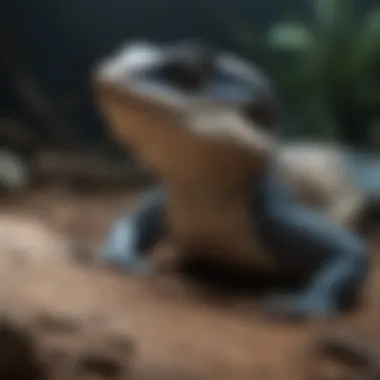
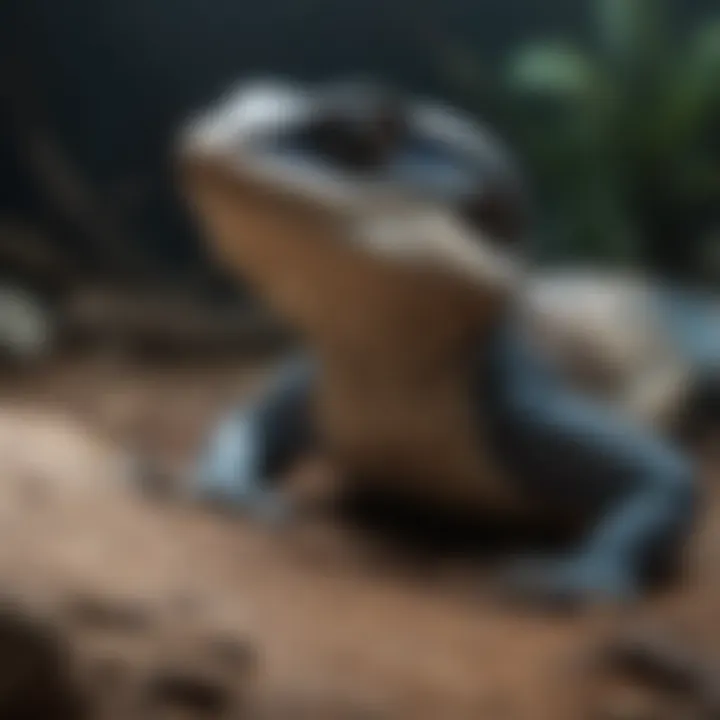
Intro
The choice of substrate for blue tongue skinks goes beyond mere aesthetics. It is a fundamental aspect of creating a suitable habitat for these reptiles. The right substrate can influence their health, behavior, and overall well-being. As keepers delve into the nuances of substrate types, understanding the needs of blue tongue skinks becomes crucial. Factors such as moisture retention, ease of cleaning, and temperature regulation all play significant roles in substrate selection.
For both novice keepers and seasoned owners, comprehending these elements can lead to informed decisions that enhance the skink's environment. This article will explore different substrate options available for blue tongue skinks, examining the characteristics of organic, synthetic, and specialized substrates. Emphasizing practicality and maintenance, we aim to provide comprehensive insights that promote a thriving atmosphere for these reptiles.
Care Tips
Daily Care Routines
Establishing a daily care routine is vital. Check the temperature and humidity levels every day to ensure they remain within the appropriate range for blue tongue skinks. Remove any uneaten food and spot clean the substrate to keep the environment sanitary. Observing your skink during the daily check can also reveal changes in behavior or health.
Cage Setup and Maintenance
Creating an effective cage setup requires careful consideration of substrate choice. For blue tongue skinks, the substrate must allow for burrowing and should ideally retain moisture. Options include coconut fiber, sphagnum moss, or even specialized soil mixes. The cage should be spacious enough for these skinks to explore, with hiding spots to create a sense of security. Regularly replace or refresh the substrate to prevent any buildup of waste and bacteria.
Hygiene and Cleaning Practices
Hygiene is essential to avoid health issues. Regularly clean food and water dishes. A thorough clean of the entire cage, including substrate removal, should be performed every few weeks. This prevents the accumulation of harmful pathogens. Use reptile-safe cleaners to disinfect surfaces.
Seasonal Care Adjustments
Different seasons may require specific adjustments. In colder months, consider substrates that help maintain warmth and moisture. During summer, ensure that the substrate does not become too dry, which can affect the humidity levels in the cage. Adjust your routine based on how your skinks react to seasonal changes.
Behavioral Insights
Understanding the natural behavior of blue tongue skinks can enhance their care. These reptiles are generally social and curious. They exhibit behaviors like burrowing and basking, which can be influenced by the type of substrate.
Common Behavioral Issues and Solutions
Inadequate substrate can lead to stress-related behaviors. If a skink is constantly trying to escape or hiding excessively, it may be a sign the substrate setup is not appropriate. Ensure to provide varied textures and the ability to burrow.
Nutrition Guides
The nutrition of blue tongue skinks does not directly involve substrate but impacts their habitat setup. Proper nutrition supports their well-being and can help mitigate some behavioral issues.
Essential Diet Components
Offer a balanced diet that includes vegetables, fruits, and protein sources. Ensure that the food remains fresh and accessible, as this has implications on health and activity.
Wellness and Health
Regular health checkups are vital. Blue tongue skinks often exhibit signs of illness through changes in skin texture or appetite. Monitoring and adapting care, including substrate conditions, contributes to their overall wellness.
Enriching Activities
Providing enrichment opportunities is essential. Engaging skinks in activities helps stimulate their natural behaviors, promoting health and happiness. Regularly changing decorations and items in their environment can encourage exploration.
Understanding Blue Tongue Skinks
Understanding blue tongue skinks is essential when discussing their care, particularly regarding substrate selection. As popular pets, these reptiles require specific habitats that reflect their natural environments. Proper habitat setups can significantly influence their health, behavior, and overall well-being.
To provide the best care for blue tongue skinks, it is crucial to comprehend their needs. This understanding aids in making informed decisions about the type of substrate to use in their enclosures. By analyzing their natural habitats and behavioral traits, keepers can better determine what substrates will support their physical and psychological health.
In addition to aiding health, suitable substrate options can facilitate the skink's natural activities. These include burrowing, basking, and foraging, which are critical for their mental stimulation. Hence, exploring the general characteristics, natural habitat, and behavioral traits of blue tongue skinks will set the stage for discussing the importance of substrate selection.
General Characteristics
Blue tongue skinks, belonging to the genus Tiliqua, are identified by their stout bodies, short legs, and distinctive blue tongue. These reptiles are medium-sized, with adult lengths ranging from 18 to 28 inches. They typically have a robust build and possess smooth scalation. The coloration varies, often appearing in shades of brown, grey, or green, which helps in camouflage within their natural habitat.
Their blue tongue is not only for show; it serves a vital role in defense. When threatened, blue tongue skinks can display the blue tongue as a warning to potential predators. Their general characteristics also include a somewhat docile demeanor, making them suitable pets for both novices and experienced reptile enthusiasts.
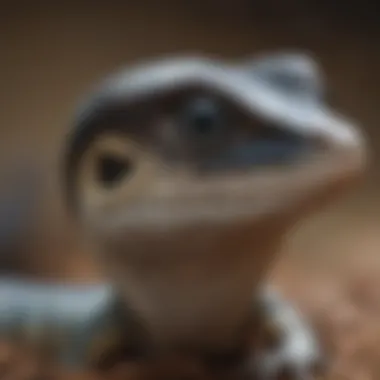
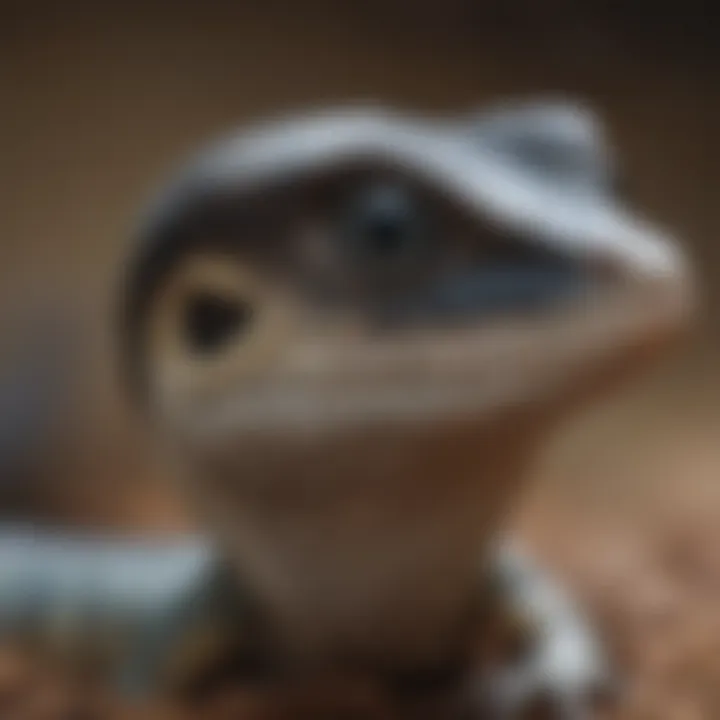
Natural Habitat
In the wild, blue tongue skinks inhabit diverse environments, mainly in Australia and New Guinea. These habitats range from open woodlands and grasslands to scrublands and even urban areas. Typically, they prefer areas with plenty of hiding spots, such as rocks, logs, and vegetation, which play a crucial role in their survival, offering shelter from predators and harsh weather conditions.
Understanding their natural habitat is essential for creating an appropriate environment in captivity. Replicating the conditions they are familiar with can positively impact their stress levels and overall behavior.
Behavioral Traits
Behaviorally, blue tongue skinks exhibit both social and solitary characteristics. These reptiles tend to be curious creatures, often exploring their enclosures. They enjoy basking under heat sources to regulate their body temperature, which is vital for their metabolism.
Burrowing is another common behavior, as these skinks will dig into substrates to create a comfortable resting space. They are also known to be less active during colder periods, exhibiting a tendency for brumation, similar to hibernation. Understanding these behavioral traits is essential when setting up their habitat and selecting suitable substrates. A well-rounded approach considers both their physical needs and behavioral tendencies to create a thriving environment.
Importance of Substrate Selection
The selection of substrate is not a mere aesthetic choice for blue tongue skinks but a fundamental aspect of their overall care. Substrate plays a vital role in the well-being of these reptiles. It affects their health, behavior, and ability to perform natural activities. For those tending to blue tongue skinks, understanding the significance of substrate selection is essential.
Impact on Health
Choosing the right substrate can directly influence the health of blue tongue skinks. A substrate that retains moisture to a proper level is important for the skin and respiratory health. For instance, if the substrate is too dry, it can lead to dehydration. Conversely, moisture-retaining substrates may lead to problems like mold growth, which can be harmful. Caregivers should also avoid substrates that may cause injuries, such as sharp or overly grainy materials.
- Natural Fibers: Organic substrates, such as coconut coir or aspen shavings, provide good absorbency without sharp edges.
- Avoidance of Chemicals: One must ensure that the substrate is free of chemicals or pesticides that may harm skinks.
The importance of substrate selection cannot be overstated. A suitable substrate promotes a healthy skin condition and minimizes risks of infection or irritation.
Effects on Behavior
The substrate impacts the day-to-day behavior of blue tongue skinks. Certain substrates allow for natural behaviors, such as burrowing and exploring. This is crucial for their mental stimulation and overall happiness. For example, loose substrate encourages blue tongue skinks to dig, mimicking their behavior in the wild.
- Naturalistic Settings: Substrates that replicate their natural habitat can help in reducing stress levels.
- Basking Behavior: Some substrates assist in heat retention, forming a conducive environment for basking, which is vital for thermoregulation.
Behavioral enrichment through appropriate substrate selection contributes to a more fulfilled existence for blue tongue skinks.
Facilitation of Natural Activities
A well-chosen substrate facilitates the performance of natural activities. Blue tongue skinks are known for their instincts to roam, burrow, and forage. Substrates that are too compact may hinder movement and natural exploration. On the other hand, more diverse substrates can allow skinks to display their natural instincts effectively.
- Foraging: Appropriate substrate helps blue tongue skinks to search for food naturally, teaching them necessary skills in a safe environment.
- Burrowing: Loose substrates encourage burrowing, which is central to their instinctual behaviors and comfort.
The correct substrate type ultimately supports a balanced behavioral repertoire, crucial for the total well-being of blue tongue skinks.
Types of Substrates
The selection of substrate plays a crucial role in maintaining a healthy and stimulating environment for blue tongue skinks. These reptiles are known for their specific habitat needs, which makes the choice of substrate an important factor. The right substrate not only supports the physical and psychological well-being of these animals but also simplifies maintenance for the caretaker. This section delves into the various categories of substrates, outlining their unique qualities and how they can cater to the distinct needs of blue tongue skinks.
Organic Substrates
Types of Organic Material
Organic substrates commonly include materials like coconut coir, aspen shavings, and peat moss. Each type offers distinct benefits. For example, coconut coir is derived from the husk of coconuts and is known for its excellent moisture retention. This property makes it valuable for maintaining humidity within the terrarium, which is essential for the health of blue tongue skinks. Aspen shavings, on the other hand, provide a lightweight option that is easy to clean. They do not mold easily and stay dry, which prevents bacterial growth.
These types of organic materials also add to the natural feel of the enclosure. They allow the skinks to dig and burrow, exercises behavior similar to what they would exhibit in the wild. This naturalistic approach can significantly enhance their overall well-being.
Pros and Cons
When considering the pros and cons of organic substrates, it is evident that they have considerable benefits. They usually promote a natural environment and can be more aesthetically pleasing. Moreover, they tend to be biodegradable, offering an eco-friendly option.
However, some organic substrates may come with downsides. For instance, peat moss can sometimes lead to compaction, which may create a hard surface that could restrict burrowing behaviors. Additionally, without proper care, some organic substrates can become breeding grounds for pests.
Synthetic Substrates
Common Synthetic Options
Synthetic substrates include products like reptile carpet, glass sand, and paper-based options. Reptile carpet is particularly favored for its easy maintenance. It can be cleaned and reused multiple times, minimizing waste. Glass sand is a substrate that provides good drainage but must be used with caution due to the risk of ingestion.

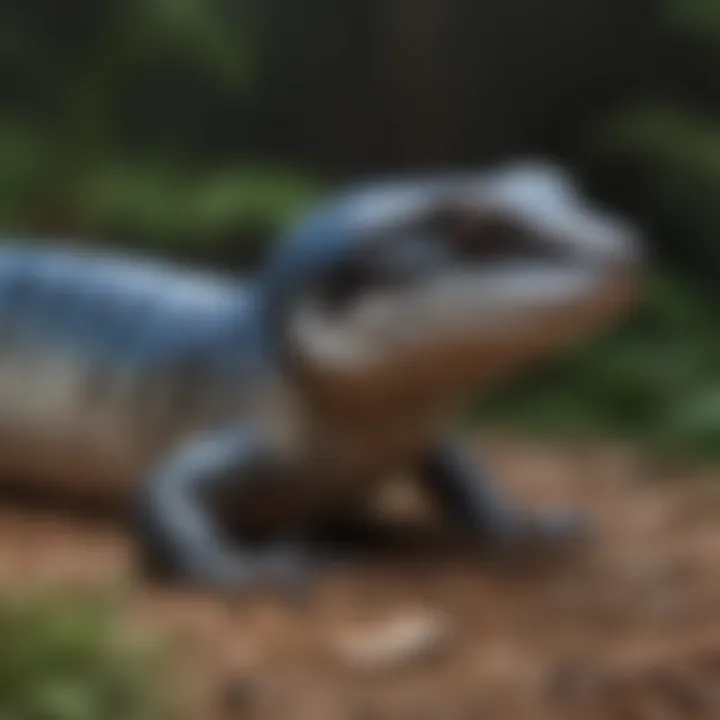
These substrates offer unique features. For example, paper-based options, like newspaper or paper towels, are simple and affordable ways to line a tank. They are easy to replace, and they provide a clean surface, although they lack the aesthetic appeal of organic options.
Advantages and Disadvantages
The advantages of synthetic substrates include durability and ease of maintenance. They can be washed or replaced quickly, making them convenient choices for busy owners. However, they may not replicate the natural behaviors of skinks as effectively as organic options. For instance, while reptile carpets prevent digging, they do not allow for the same level of interaction typical in a natural setting.
Specialized Substrates
Calcium-Based Substrates
Calcium-based substrates, such as calcium sand, are a specialized option designed to help meet dietary needs. Blue tongue skinks may consume small amounts of substrate while feeding, making calcium-based options beneficial in providing essential nutrients. These substrates also allow for burrowing and digging, both of which are important behaviors for blue tongue skinks.
However, using calcium substrates comes with the downside of possible overconsumption. If skinks ingest too much sand, it can lead to health issues. Care must be taken to ensure that these substrates are used in moderation and replaced as required.
Humidity Control Substrates
Humidity control substrates are designed to help regulate moisture levels within the terrarium. Materials such as sphagnum moss can hold significant amounts of water and are ideal for creating humidity levels that are comfortable for blue tongue skinks. These substrates can also help facilitate shedding, which is critical for the skink's health.
The downside of these substrates is that they may require more frequent maintenance to keep the humidity levels in check. Excess moisture can lead to mold growth if not monitored closely. Regular checks and replacements will be necessary to prevent health risks associated with improper humidity.
Choosing the right substrate involves balancing the natural behaviors of blue tongue skinks with your capabilities for maintenance.
Assessment of Substrate Materials
The evaluation of substrate materials is essential for the well-being of blue tongue skinks. Substrate not only serves as the foundation for their environment but also impacts their health, behavior, and overall quality of life. When assessing substrates, three key elements must be considered: texture and composition, absorbency, and cleanliness and maintenance. Each of these factors plays a crucial role in creating a habitat that caters to the needs of blue tongue skinks.
Texture and Composition
Texture and composition are critical aspects when selecting substrate. Blue tongue skinks thrive in environments that mimic their natural habitats. Thus, the substrate must provide not just comfort but also safety when the skinks burrow or explore. The preferred texture is often loose and sandy, allowing the animal to dig.
Common substrates include coconut coir, bark, or sand. Each material has its unique feel and structure. For instance, coconut coir is soft and easy for skinks to navigate, while sand can be appealing due to its natural look. However, too fine a sand may cause respiratory issues if inhaled. Also, consider the substrate's composition. Avoid materials that can decompose improperly or release harmful chemicals.
"The right substrate texture and composition can prevent stress and promote natural behaviors in blue tongue skinks."
Absorbency
Absorbency is another pivotal property of substrate materials. Proper substrate should effectively absorb waste and moisture, helping to maintain humidity levels that blue tongue skinks require. Materials like paper towels are easy to clean but may struggle with long-term absorbency when moisture accumulates.
In contrast, substrates like cypress mulch offer better absorbency and allow for a more natural humidity level in the enclosure. Still, it requires regular maintenance to prevent mold growth. Monitor how well the substrate absorbs waste and moisture to ensure an optimal living environment for your skinks.
Cleanliness and Maintenance
Cleanliness and maintenance are paramount when assessing substrate materials. Regular cleaning prevents the build-up of bacteria and waste, which can be harmful to blue tongue skinks. Materials such as newspaper provide the easiest maintenance since they can be easily replaced. However, they lack aesthetic value.
Natural substrates like aspen shavings or coconut coir can create a more stimulating environment but require more effort to keep clean. It's critical to establish a cleaning routine based on the type of substrate chosen. Consistent monitoring will help you address any potential problems with cleanliness just as they arise, ensuring your skinks stay in a healthy environment.
By assessing these materials with careful thought, blue tongue skink owners can substantially influence the quality of their pets' habitats, leading to healthier, more active reptiles.
Substrate Management
Substrate management plays a vital role in fostering a healthy environment for blue tongue skinks. Properly maintained substrate enhances not only the physical setting but also contributes significantly to the overall well-being of these reptiles. This management extends beyond mere cleaning; it includes routine assessments, humidity control, and pest monitoring. By investing time in substrate management, keepers can ensure their skinks thrive in a naturalistic habitat that minimizes stress and encourages normal behaviors.
Routine Cleaning and Replacement
Regular cleaning and substrate replacement are essential. Neglecting these tasks can lead to the accumulation of waste and bacteria, which might adversely affect the health of blue tongue skinks. A clean substrate aids in maintaining stable humidity levels and reduces the risk of pathogens. When replacing the substrate, it is important to consider the type of material being used.
Typically, a substrate should be replaced every 4 to 6 weeks. This schedule can vary based on the number of skinks, the substrate type, and the overall hygiene of the enclosure. Here are some tips for routine cleaning:
- Remove feces and uneaten food daily.
- Spot clean the substrate to prevent odor.
- Dispose of soiled substrate and apply fresh material.
- Ensure any decorations or hiding spots are also cleaned.
Managing Humidity Levels
Humidity management in the habitat of blue tongue skinks is essential for their health. The right humidity level supports skin health and helps with shedding. Too much dryness can lead to dehydration, while overly moist conditions can create a breeding ground for mold.
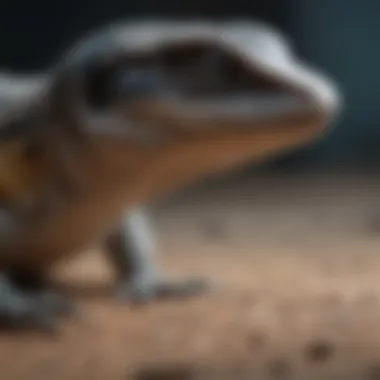
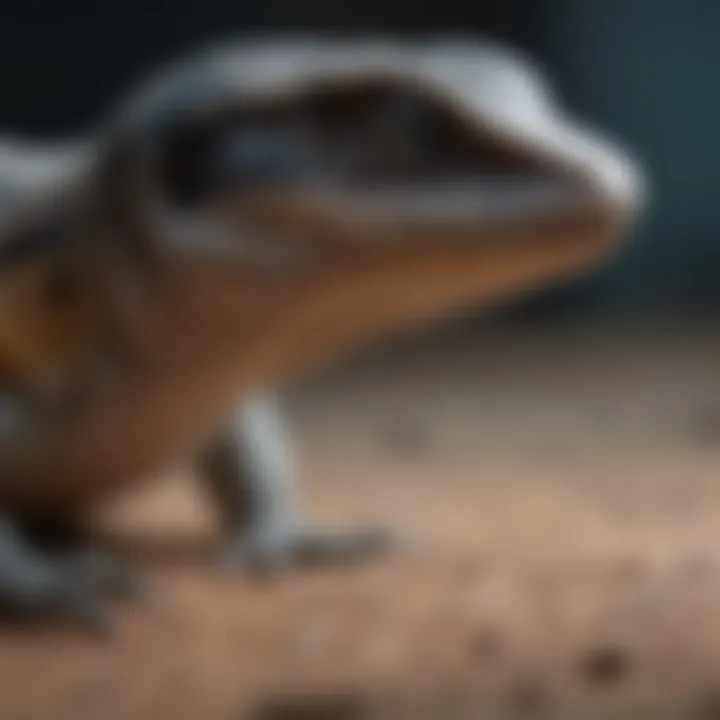
Keepers should regularly check humidity levels using a hygrometer. The ideal range is between 40-60% humidity. To maintain proper humidity:
- Mist the enclosure lightly if levels drop too low.
- Provide a water bowl large enough for soaking.
- Choose substrates that retain moisture well, such as coconut coir or sphagnum moss.
Monitoring for Pests and Molds
Vigilant monitoring for pests and molds is an imperative aspect of substrate management. Both can compromise the health of blue tongue skinks. Common pests include mites, which can cause distress and skin issues. Molds can develop in damp substrates, posing additional health risks.
Keepers should keep an eye out for signs of these issues:
- Abnormal behavior in skinks, such as excessive scratching.
- Changes in appetite or lethargy.
- Visible mold growth or the presence of insects in the substrate.
To combat these issues:
- Maintain a clean environment through regular checks.
- Use safe pest control methods if needed.
- Ensure proper ventilation to avoid stagnant air, which fosters mold growth.
It is crucial to treat both pests and molds promptly to avoid potential health problems for your blue tongue skinks.
Through diligent substrate management, the keeper can create a stable and supportive habitat. This not only benefits the individual skinks but also enriches the overall experience of keeping these fascinating reptiles.
Common Mistakes in Substrate Selection
Choosing the right substrate for blue tongue skinks is crucial. However, in the process, many keepers make mistakes that can severely impact their reptiles' health and comfort. Understanding these common pitfalls can help ensure a thriving environment for these creatures. The following sections outline some of these critical errors and their implications.
Inadequate Research
One significant error many new or even experienced keepers make is not conducting enough research before selecting a substrate. Each type of substrate has unique characteristics and requirements. A lack of understanding of these factors can lead to unsuitable conditions for blue tongue skinks.
For example, certain substrates like cedar shavings can be harmful due to their toxic properties. On the other hand, natural materials such as coconut fiber may promote better humidity levels but require specific management practices. Without adequate background knowledge, keepers may unknowingly choose a substrate that can harm their skink’s health, leading to issues such as respiratory problems or skin irritations.
"Ignoring research can jeopardize the well-being of your blue tongue skink. Prioritize understanding the material you select."
Choosing Inappropriate Materials
Selecting inappropriate materials for substrate can cause several problems. For instance, materials like aquarium gravel or sand tend to retain moisture differently compared to soil-based substrates. This can affect humidity control and, consequently, the skink's health.
Moreover, large substrate particles can pose a choking hazard. Skinks are curious animals that might accidentally ingest unsuitable materials while exploring. It is best to avoid substrates that can lead to impaction, which can be a serious health issue. Thus, knowing the exact needs of blue tongue skinks is essential to prevent these mistakes and ensure their safety.
Neglecting Environmental Needs
One of the most overlooked aspects is the neglect of the specific environmental needs of blue tongue skinks. These reptiles require a balance of humidity and temperature that is closely linked to the substrate used.
For instance, if a keeper uses a substrate that dries out too quickly or retains too much moisture, it can lead to stress and health issues such as dehydration or respiratory infections. Additionally, the substrate should allow for burrowing behavior, as blue tongue skinks naturally dig in their habitat. Failing to create an environment that mirrors their natural habitat can hinder their behavioral health and overall satisfaction.
In summary, the selection of substrate is not trivial. Keepers must avoid inadequate research, inappropriate material choices, and neglect of environmental needs to protect the health and happiness of their blue tongue skinks.
Final Considerations
Final considerations are vital in the decision-making process for selecting the right substrate for blue tongue skinks. When keepers put in the effort to reflect on individual requirements, financial implications, and environmental harmony, the overall well-being of the skinks and the success of their habitat greatly improve. These aspects often affect not just the reptile's health but also the level of satisfaction experienced by the keeper.
Evaluating Individual Needs
Evaluating individual needs is fundamental in providing proper care for blue tongue skinks. Each skink has unique characteristics that dictate their specific requirements. Factors like age, size, and behavior can greatly influence substrate choice. For example, a growing juvenile may benefit from a softer substrate that offers easier burrowing opportunities.
Keepers should also consider the skink's natural habitat while evaluating needs. If the skink comes from a region with sandy or loamy soil, replicating that as closely as possible may be advantageous. Different skinks may thrive in different conditions. Therefore, understanding these individual needs helps ensure their environment is both comfortable and beneficial.
Cost vs. Benefit Analysis
Cost versus benefit analysis is an important aspect of substrate consideration. Durable substrates may have a higher initial cost but can last longer and require less frequent replacement, potentially saving money in the long run. For instance, a high-quality synthetic substrate might be pricier but also easier to clean and maintain than cheap organic options that degrade quickly.
When calculating expenses, consider both the direct costs associated with substrate purchase and the indirect costs like potential veterinary expenses arising from inappropriate material that could harm the skink. Balance is critical here; keepers must analyze whether the benefits of a particular substrate justify its costs.
Creating a Balanced Environment
Creating a balanced environment is essential for the overall health of blue tongue skinks. A well-thought-out substrate choice contributes to temperature regulation and humidity control, both of which are crucial in maintaining a suitable habitat. For example, certain substrates retain moisture better, helping provide necessary humidity levels without the additional work of frequent spraying.
In addition, substrates should also be paired with adequate lighting and heating conditions, complementing the habitat’s overall dynamic. A balanced environment allows blue tongue skinks to express natural behaviors, promoting both physical and mental well-being.
"The right habitat is a foundation for the overall health and happiness of your reptile."















